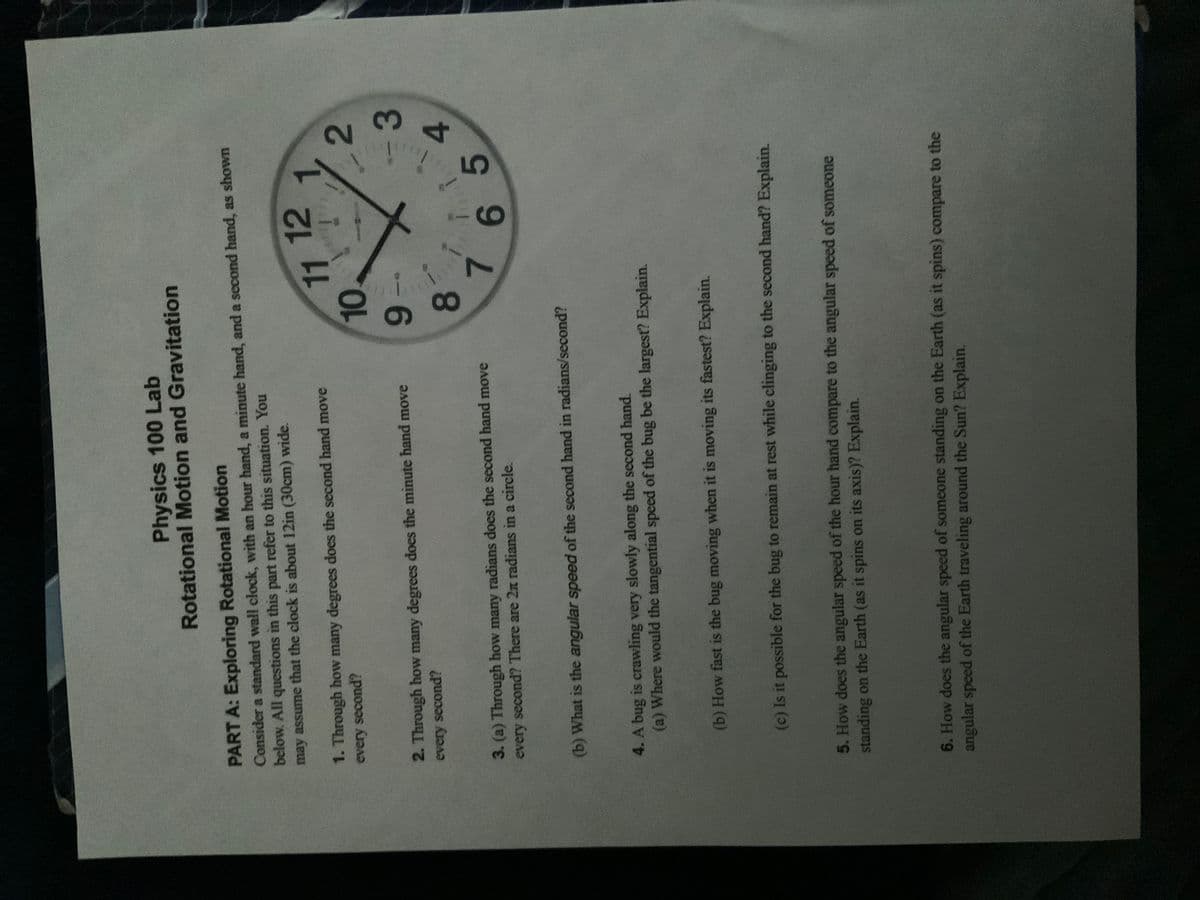2. Physics 100 Lab Rotational Motion and Gravitation PART A: Exploring Rotational Motion Consider a standard wall clock, with an hour hand, a minute hand, and a second hand, as shown below. All questions in this part refer to this situation. You may assume that the clock is about 12in (30cm) wide. 11 12 1. Through how many degrees does the second hand move every second? 10, 3 2. Through how many degrees does the minute hand move every second? 4. 3. (a) Through how many radians does the second hand move every second? There are 2n radians in a circle. (b) What is the angular speed of the second hand in radians/second? 4. A bug is crawling very slowly along the second hand. (a) Where would the tangential speed of the bug be the largest? Explain. (b) How fast is the bug moving when it is moving its fastest? Explain. (c) Is it possible for the bug to remain at rest while clinging to the second hand? Explain. 5. How does the angular speed of the hour hand compare to the angular speed of someone standing on the Earth (as it spins on its axis)? Explain. 6. How does the angular speed of someone standing on the Earth (as it spins) compare to the angular speed of the Earth traveling around the Sun? Explain.
2. Physics 100 Lab Rotational Motion and Gravitation PART A: Exploring Rotational Motion Consider a standard wall clock, with an hour hand, a minute hand, and a second hand, as shown below. All questions in this part refer to this situation. You may assume that the clock is about 12in (30cm) wide. 11 12 1. Through how many degrees does the second hand move every second? 10, 3 2. Through how many degrees does the minute hand move every second? 4. 3. (a) Through how many radians does the second hand move every second? There are 2n radians in a circle. (b) What is the angular speed of the second hand in radians/second? 4. A bug is crawling very slowly along the second hand. (a) Where would the tangential speed of the bug be the largest? Explain. (b) How fast is the bug moving when it is moving its fastest? Explain. (c) Is it possible for the bug to remain at rest while clinging to the second hand? Explain. 5. How does the angular speed of the hour hand compare to the angular speed of someone standing on the Earth (as it spins on its axis)? Explain. 6. How does the angular speed of someone standing on the Earth (as it spins) compare to the angular speed of the Earth traveling around the Sun? Explain.
Physics for Scientists and Engineers, Technology Update (No access codes included)
9th Edition
ISBN:9781305116399
Author:Raymond A. Serway, John W. Jewett
Publisher:Raymond A. Serway, John W. Jewett
Chapter10: Rotation Of A Rigid Object About A Fixed Axis
Section: Chapter Questions
Problem 10.93CP: A merry-go-round is stationary. A clog is running around the merry-go-round on the ground just...
Related questions
Question
4(b) How fast is the bug moving when it is moving its fastest? Explain.

Transcribed Image Text:2.
90
Physics 100 Lab
Rotational Motion and Gravitation
PART A: Exploring Rotational Motion
Consider a standard wall clock, with an hour hand, a minute hand, and a second hand, as shown
below. All questions in this part refer to this situation. You
may assume that the clock is about 12in (30cm) wide.
1. Through how many degrees does the second hand move
every second?
11 12
10.
2. Through how many degrees đoes the minute hand move
3
every second?
3. (a) Through how many radians does the second hand move
every second? There are 2n radians in a circle.
4.
(b) What is the angular speed of the second hand in radians/second?
4. A bug is crawling very slowly along the second hand.
(a) Where would the tangential speed of the bug be the largest? Explain.
(b) How fast is the bug moving when it is moving its fastest? Explain.
(c) Is it possible for the bug to remain at rest while clinging to the second hand? Explain.
5. How does the angular speed of the hour hand compare to the angular speed of someone
standing on the Earth (as it spins on its axis)? Explain.
6. How does the angular speed of someone standing on the Earth (as it spins) compare to the
angular speed of the Earth traveling around the Sun? Explain.
Expert Solution
Step 1
We have clock of total width d=30 cm so the radius or size of a hand R=d/2=30/2=15 cm. Also we know that the second hand covers in 60 s.
Trending now
This is a popular solution!
Step by step
Solved in 2 steps

Knowledge Booster
Learn more about
Need a deep-dive on the concept behind this application? Look no further. Learn more about this topic, physics and related others by exploring similar questions and additional content below.Recommended textbooks for you

Physics for Scientists and Engineers, Technology …
Physics
ISBN:
9781305116399
Author:
Raymond A. Serway, John W. Jewett
Publisher:
Cengage Learning

College Physics
Physics
ISBN:
9781305952300
Author:
Raymond A. Serway, Chris Vuille
Publisher:
Cengage Learning

College Physics
Physics
ISBN:
9781938168000
Author:
Paul Peter Urone, Roger Hinrichs
Publisher:
OpenStax College

Physics for Scientists and Engineers, Technology …
Physics
ISBN:
9781305116399
Author:
Raymond A. Serway, John W. Jewett
Publisher:
Cengage Learning

College Physics
Physics
ISBN:
9781305952300
Author:
Raymond A. Serway, Chris Vuille
Publisher:
Cengage Learning

College Physics
Physics
ISBN:
9781938168000
Author:
Paul Peter Urone, Roger Hinrichs
Publisher:
OpenStax College

University Physics Volume 1
Physics
ISBN:
9781938168277
Author:
William Moebs, Samuel J. Ling, Jeff Sanny
Publisher:
OpenStax - Rice University

An Introduction to Physical Science
Physics
ISBN:
9781305079137
Author:
James Shipman, Jerry D. Wilson, Charles A. Higgins, Omar Torres
Publisher:
Cengage Learning
